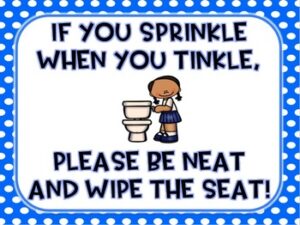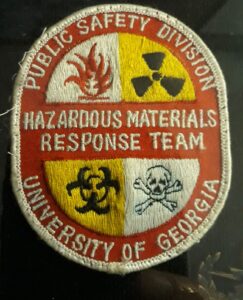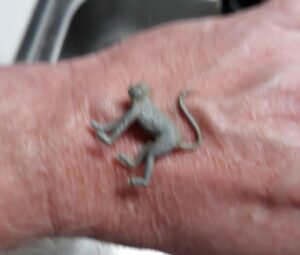…Well, that should be enough of a hot-take title to garner some angry retweets on Twitter,

A couple of mornings ago, as I entered the bathroom stall at work to begin my morning paperwork conference call on the white porcelain phone, I noticed that some nasty-ass slob had left the seat down and sprinkled the pristine white surface with urine. Normally, that’s not an issue; as the custodial staff generally cleans this bathroom before it’s time for the Brown Line to leave the station.
As I stood there looking at the amber droplets (someone needs to hydrate!) drying on the rim, my gaze traveled upwards to the these days ubiquitous container of flushable paper toilet seat covers. I would have just grimaced and wiped the seat dry with some toilet paper, but a stray thought leapt unbidden to my mind:
MONKEYPOX!!
It’s not that unreasonable a thought. Shit, we’ve been living through three years of rotating pandemics; a thought like that is be expected.
So, little flap situated in the bowl, I gently nested my derriere on the barrier and thought about the first time I’d ever seen a toilet seat cover, around 1989.

At the time, I was working as a dispatcher for the UGa Public Safety Division. It was, in those days, a “Division” rather than a “Department”, as it incorporated Environmental Health and Safety as well. Located in a two story building, the bottom floor housed the Police Department; and the top, EHS and Administration. Needless to say, the bathrooms were much nicer on the second floor; so if I was working after business hours when all the whiteshirts had left for the day, I’d do my business up there.
And it was there that I saw my first toilet seat cover. I knew they were there; there had been a memo circulated a few months prior where we were all informed that a member of EHS had been diagnosed with AIDS- but it was OK, because they were providing these covers.
Did those covers do much, if anything, to protect against getting AIDS from a toilet seat? Can you, in fact, get AIDS from a toilet seat at all?
No. No, you cannot. But this was still relatively early days of the AIDS epidemic, and Reaganite misinformation still persisted (Thanks, Nancy!)… as did the stigma of having AIDS or HIV. You don’t think there was speculation over just who in EHS had AIDS? Of course there was. “What about that John, guy? He looks queer to me”. And those seat covers wouldn’t have done anything even if you could get HIV from a toilet seat; other than as a psychological balm for your jangled, misinformed nerves.
“I checked with epidemiology before calling you back, just to be sure,” said Sharon Greenman, environmental health services supervisor with the Seattle/King County Department of Public Health. “She agreed with what I thought, which is that they probably do absolutely no good whatsoever other than psychological.” I’m pretty sure she meant the toilet-seat covers, not epidemiology. (see second link)
And, even though I dried the seat before applying the cover, it probably wouldn’t help against monkeypox, either; even if you could catch it from a toilet seat- a myth (catching diseased from a toilet seat) that persists today.
So, why do we still have toilet seat covers?
Psychological nerve-soothing. No matter that it still perpetuates the catching-AIDS-from-a-toilet-seat myth (or swimming in a pool, or standing next to an HIV+ person) that made being HIV+ a social death sentence.
OK, so that’s toilet seat covers; WTF are “S&A” cards?

Remember I started my eventual Law Enforcement career as a “service officer” (read: unarmed security guard working for the DPS) and then dispatcher. And in 1989, dispatch was a different place than it is today- paper call logs, a dumb terminal for writing reports, another for the NCIC/GCIC terminal that let us check for warrants, a double reel-to-reel recorder that recorded phone calls and radio traffic… we even monitored some alarms for campus buildings; the monitor was a bank of peanut bulbs with labels and a buzzer. And we were considered fairly high-tech for a southern PD of the time!
Anytime an Officer encountered another person, we would fill out a “Service and Assistance” card with that person’s information, description, and a summary of the call that would get stored in a bank of card file drawers. If an Officer was out with someone they thought might be a repeat customer- for example, on a traffic stop and they thought they remembered the name- they’d ask to “check the S&A”. The dispatcher would open the correct alphabetized drawer and flip through to the last name, and check how many cards there were for the person and why they were filled out. “10-4, 845; two warnings for running a red light on 10/23 and 9/1 of this year.” The Officer would then scratch out a ticket after informing the driver that he’s already had two warnings for the same thing and this is the third strike.
There was also a space on these cards for hazards: “Known to carry weapons”, or “Suspect in several B&Es”, or “Has fought with officers before, dispatch 10-78”.
Or… “Universal Precautions”.
First responders reading this will immediately grasp what “Universal Precautions” means. These days it’s usually called “Personal Protective Equipment”; or PPE. But no matter what you call it, it means latex gloves…
…and it means the person is known to have an infectious disease.
“Well, what’s so bad about that? Shouldn’t the Officer know that information about someone they’re going to have to put hands on?”
Well, HIPAA wasn’t passed until 1996… But, even then, it only applies to health plans, health care clearinghouses, and health care providers; NOT Law Enforcement. And, believe me, there are times that you really wished you had this information…
…Like the time I had an arrestee in the back seat of my squad, before we had cages separating the front and back seats (because we were a University PD and cages were deemed to look too aggressive), who had been coughing non-stop on the trip to the jail. While I was in booking, filling out my paperwork, I heard the jailer asking the arrestee the usual health questions…
…And heard him say he had TB.
Yeah. Vaccination or no, that’s really a damper on your evening, learning you’ve spent 20 minutes in an enclosed space with someone who’s been hacking up a lungful of TB.
BUT… there was one little tick mark that got added to the end of “UP” that indicated something special. It was a little + sign, and it meant the person was HIV positive. And when an Officer heard that in 1989, they immediately shrank away and started donning as many pairs of gloves as they could, and repeatedly dousing their hands in antiseptic gel.
Yes, it’s true that the myths of HIV were still strong in 1989; and the fact that if the guy’s not bleeding onto your own open wound, the chances of contracting it were virtually nil, were still largely unknown. That’s a fault of public health messaging and the (sometimes) unconscious biases of the public against homosexuality; especially amongst Law Enforcement.

But that little + continued to bias LE for YEARS after this. It really wasn’t until HIPAA passed- thanks to misinformation about who was subject to HIPAA that persists today- that the UP marker was removed from S&A cards, and their digital equivalent, at that agency.
But everything that’s old is new again; especially in an era of ultra-conservatism that makes Reaganites look like the Weather Underground. Monkeypox has become the latest far-right “gay plague” (although that idea probably won’t get much traction as it isn’t primarily a sexually transmitted disease- wait ‘til DeSantis catches it).
And lo and behold, we’re drug right back around to toilet seat covers and my fears of monkeypox; and the stigmatization of homosexuals over a disease.
